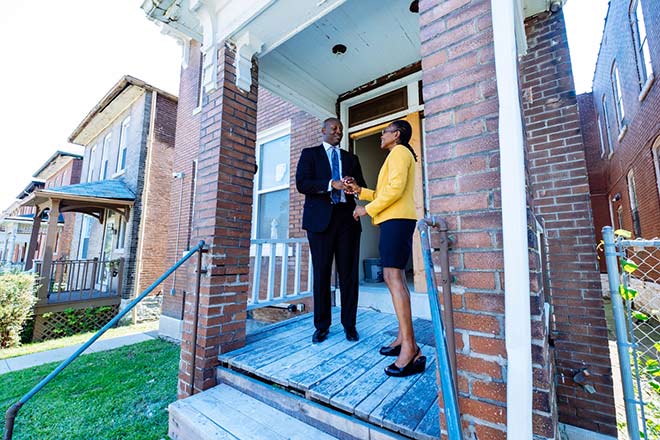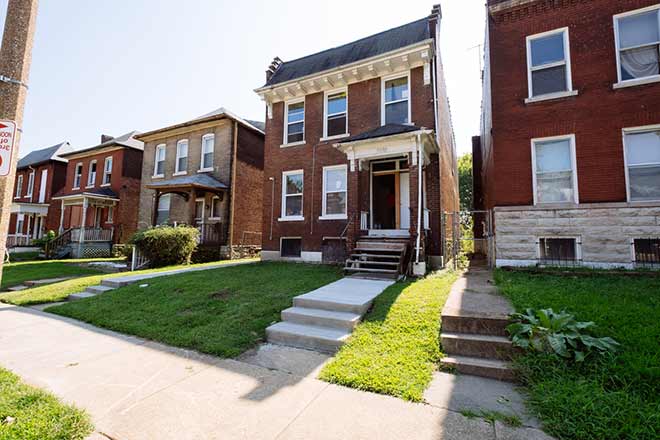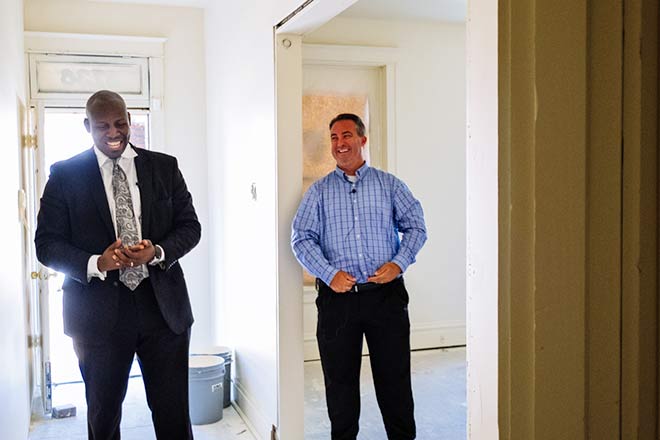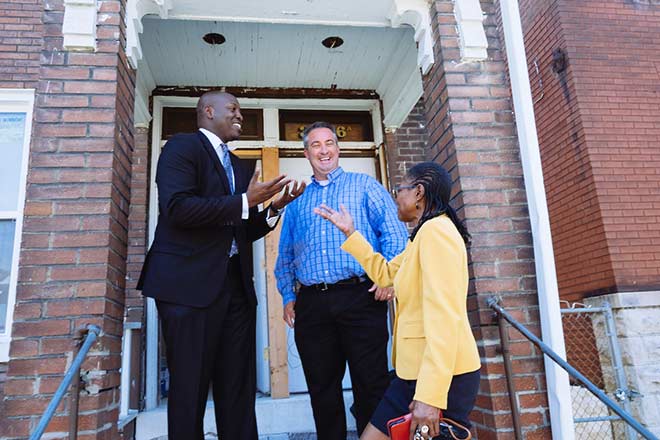Rebuilding Homes and Restoring Hope in North St. Louis
For Andre Alexander, restoring old properties in St. Louis City’s North corridor is about more than real estate.
It’s about restoring hope to those who live there.
“When residents see that other people care to invest in the neighborhood and preserve the history, then people gain hope,” he says.

Andre Alexander leads Tabernacle Community Development Corporation, a nonprofit that is restoring homes and building morale in North St. Louis neighborhoods.
Alexander serves as lead pastor of North St. Louis-based The Tabernacle church and president of its community development arm, Tabernacle Community Development Corporation (CDC). This CDC strives to eliminate poverty and exclusion by improving social, educational and economic infrastructure.
Safe housing is a critical part of that infrastructure. As vacancy rates soar in the city’s historically disinvested African American communities, Alexander — a St. Louis native and engineer by training — isn’t one to stand on the sidelines.
So last September, he overcame a case of nerves and headed to the St. Louis Fed, seeking to convince a roomful of funders to support Tabernacle CDC’s Affordable Rental Program. He knew he’d be pitching to a mix of potential funders, including banks, foundations and community development financial institutions (CDFIs).
The pastor hoped to secure financing to rehabilitate a few historic homes.
He got that … and so much more: Tabernacle found a productive funding partner in Midwest-based Gateway CDFI; Alexander found a new friend and collaborator in Jaycee Greene, Gateway’s community development lender.
Below is one organization’s story of progress and possibility, facilitated in part by the St. Louis Fed’s Investment Connection program.

Andre Alexander of Tabernacle CDC greets Yvonne Sparks of the St. Louis Fed during a recent site visit. Alexander’s organization is restoring this historic North City property with help from a funding partnership facilitated by the St. Louis Fed’s Investment Connection program.
Making Investment Connections in Our Region
The St. Louis Fed is not a grant-making organization. But as a regional bank within the Federal Reserve System, we provide advisory services to promote community and economic development in the Eighth District.
One of the ways we do that is through Investment Connection. The program brings together nonprofit organizations, bankers, foundations, and public and private funders.

The Eighth District includes Arkansas, southern Illinois, southern Indiana, western Kentucky, northern Mississippi, eastern Missouri and western Tennessee (shaded). View a county-level map.
At live events throughout the year, these parties meet and explore community development opportunities in the areas they serve—especially those in low- and moderate-income, distressed and underserved communities.
Notably, community and economic development organizations like Tabernacle CDC get to pitch their programs to multiple financial institutions and other public and private funders, all at once.
The St. Louis Fed, meanwhile, ensures that all projects selected to be pitched are eligible for funding under the Community Reinvestment Act (CRA). This 1977 law requires federal financial regulatory agencies to encourage regulated financial institutions to help meet the credit needs of their communities.
Alexander says that prior to participating in Investment Connection, he was not familiar with the Community Reinvestment Act or how his organization’s projects might qualify.
That’s why our Community Reinvestment Initiatives team helps organizations like his understand what banks are looking for when funding CRA-eligible projects.
One of the team’s goals is to provide organizations with the tools to successfully engage with banks and other funders, explains Assistant Vice President Yvonne Sparks.
“In convening community development organizations and funders, we learn how we can share and leverage resources to get to ‘yes’ for the projects that serve communities,” she says.
Investing in the North Corridor
Tabernacle CDC emerged in 2014 from The Tabernacle, a church nestled along Ashland Avenue. The church itself has an extensive history of engagement in North St. Louis, springing from its collaboration with St. Louis Public Schools to provide resources to the community.
Its CDC formed with the purpose of revitalizing two nearby neighborhoods: JeffVanderLou and The Ville.
A new study by the Interdisciplinary Environmental Clinic at Washington University’s School of Law notes that more than 90% of St. Louis’ “exceptionally large” inventory of vacant properties are located in majority-black neighborhoods, including several near The Tabernacle. A dearth of livable housing contributes to adverse health effects, increased poverty, and decreased quality of life, says the report on environmental racism.
In fact, much of the North St. Louis City corridor today mirrors redlined maps from almost 70 years ago, where predominantly African American neighborhoods like JeffVanderLou and The Ville were marked as “hazardous” and denied investments from financial institutions.
To provide residents of these neighborhoods with a glimmer of hope, Tabernacle CDC created the Affordable Rental Program. Its goal is to create a home environment that is safe and secure, thus addressing the emotional and spiritual well-being of residents.
The project began in 2016 with a focus on providing affordable housing that honors the rich architecture of the neighborhood. Each home Tabernacle CDC renovates highlights the character and the integrity of these historical structures, such as preserving 1920s pocket doors and fireplace mantels.
“You can’t find quality architecture like the crown molding and brick in the homes of the JeffVanderLou and Ville neighborhoods, and we have the duty of preserving these high-quality products when renovating homes,” Alexander says.

During a recent site visit, Andre Alexander shows the St. Louis Fed’s Community Reinvestment Initiatives team one of the multifamily homes that Tabernacle CDC is renovating.

Brick homes in the city’s historically African American neighborhoods of JeffVanderLou and The Ville boast distinctive architecture like crown molding. Alexander says his organization is committed to retaining these features.

Once renovations are complete, this home in North St. Louis City will be more than a dwelling: Tabernacle CDC’s Affordable Rental Program aims to help potential residents find stability.
Historic homes renovated through the Affordable Rental Program have an extensive list of potential residents. Tabernacle applies an “affordable housing with a twist” approach when selecting families for its properties: The CDC considers a family’s real financial standing, and it conducts a thorough interview with a housing coordinator to see if the family is seeking not only a place to live, but also to transform their lives.
“Rent is set according to what you can afford and not necessarily what someone says you have to pay,” Alexander says.
That’s a key part of the organization’s model. While enhancing investments in the region, Tabernacle CDC believes it can assist in building the community’s morale.
Pitching at the Live Event
The Affordable Rental Program is Tabernacle’s first Community Reinvestment Act-eligible project.
How did it get funding?
Thinking back, Alexander recalls how he learned about Investment Connection through a communication from the St. Louis Fed. He’d heard stories about CRA projects, but again, didn’t know how the act worked or how to best obtain funding.

Andre Alexander was excited to “pitch” to potential funders during a live Investment Connection event held Sept. 18, 2018, at the St. Louis Fed. In all, the event featured 10 CRA-eligible projects.
Thus, when he received the emailed request for proposal, he leaped at the opportunity to learn more about the CRA and to bring more investments to JeffVanderLou and The Ville.
Although Alexander was initially nervous about pitching, he was excited to be in the room with multiple potential funders at one time. For a relatively small community development corporation, it would have taken Tabernacle weeks if not months to individually meet with each funder who attended the live event.
During Investment Connection’s speed networking round, Tabernacle and several other selected organizations experienced 10-minute networking opportunities to engage with funders.
It was during these rounds when Alexander met with Jaycee Greene, a community development lender from Gateway CDFI.
“The speed networking provided opportunity to more intimately engage with funders and form additional connections,” Alexander says. “I didn’t have to sell Jaycee on our project, because he was deeply interested in doing an affordable housing project that would positively impact residents in the JeffVanderLou and The Ville neighborhoods.”
Helping Funders Find CRA-Eligible Projects to Support

Jaycee Greene of Gateway CDFI learned about Tabernacle CDC during a 2018 Investment Connection event. He was impressed with Andre Alexander’s presentation and vision.
Investment Connection helps banks, foundations, government entities and others find funding opportunities in support of the Community Reinvestment Act.
Gateway CDFI is a certified community development financial institution. It was established in 2009 to provide nontraditional loan products and development consulting services to underserved areas, including communities in Missouri.
Greene says that prior to participating in the Investment Connection live event, Gateway had not heard of Tabernacle CDC.
But, he notes, “After listening to Andre’s presentation and getting a chance to talk with him during the speed networking round, I was very impressed with both his experience with affordable housing and the way the organization had already successfully completed several redevelopments on its own.
“Given those attributes, the financial wherewithal of the CDC, and the strength of Andre’s leadership, Gateway CDFI was able to provide a significant loan commitment within three months of the Investment Connection event and closed on a loan within six months,” Greene continues.
In addition, he estimates that Investment Connection reduced the loan approval process time for Gateway by approximately three months.
“The Investment Connection event provided Gateway with a quick and efficient way to hone in on organizations and projects that fit our lending profile,” Greene says. “The event also lent a certain level of credibility to the presenting organizations, given their work beforehand with the St. Louis Fed.”
More than Just a Onetime Funding Partnership
Alexander says that he and Greene corresponded through email, phone calls and site visits after the event as they worked to develop a funding partnership. So far, Tabernacle CDC has been able to renovate three multifamily homes in North St. Louis City as a result of its connection with Gateway CDFI.
But Alexander describes his relationship with Greene as much more than a funding partnership: Greene played a pivotal role in connecting Tabernacle to a bank to help secure a line of credit, and provided connections to other funders, as well.
“Jaycee is a master of looking at where you are, where you want to go, and the steps you need to get there,” Alexander says. “He helped us piece together the puzzle of, ‘Here’s what Gateway can do, and here’s the part where I know some people who can help.’”

Andre Alexander, left, and Jaycee Greene developed both a friendship and professional funding partnership after meeting at a St. Louis Fed Investment Connection live event. The two men say they have learned a great deal from each other.
In just over a year, he and Greene went from strangers to collaborators who regularly communicate, leveraging one another’s expertise.
In addition to a monetary investment of $400,000, Tabernacle reallocated resources to begin five additional projects aimed at serving the communities of JeffVanderLou and The Ville. These projects included purchasing a building to create a community resource center.
Moreover, Greene connected Tabernacle with a smaller nonprofit that is working in the College Hill area, a neighboring community to JeffVanderLou and The Ville. Through this connection, Tabernacle CDC provided mentorship to the community development organization.
For Alexander, it’s about paying forward the knowledge he’s acquired.
“The educational component of the Investment Connection program has been extremely helpful," he says. He recalls how, during the 2018 live event, he’d been eager to discover the work that other nonprofits were doing to improve St. Louis communities.
What Participating Funders and Organizations Say
Our Investment Connection program officially launched in 2017. In its first 22 months, 90 organizations responded to requests for proposals; 284 bankers and other funders attended live events; and 241 documented connections were made.
“The Investment Connection program provides a platform for community development organizations and funders to form meaningful connections that lead to tangible results for communities,” Sparks says.
As the program grows, the St. Louis Fed team is developing resources to make it even better. For example, Sparks says, our Community Reinvestment Initiatives team is now incorporating CRA training prior to live events.
We’re also gathering feedback from participants and listening to their input. In a recent short-term outcomes survey, CDFIs and other funders indicated they most valued:
- Hearing about multiple projects in one setting.
- Knowing that all projects presented have been vetted for Community Reinvestment Act eligibility.
Survey respondents also cited awareness of community development issues/opportunities and connections with peers as beneficial.

Andre Alexander, Jaycee Greene and Yvonne Sparks discuss Tabernacle CDC’s progress restoring a multifamily home in North St. Louis City. Organizations like Tabernacle say they value training and skills from Investment Connection, and organizations and funders alike say they enjoy having multiple opportunities to connect in one setting.
Meanwhile, Alexander shares that he is thankful for the opportunities Investment Connection has provided. He calls the program an effective method “to bring more exposure and capital” to Tabernacle CDC’s projects, including its Affordable Rental Program.
For organizations like his, he says key outcomes include:
- Robust education about the Community Reinvestment Act.
- Ability to engage with high-level bankers and funders in one setting.
- Connections with funders and other community development organizations.
The greatest outcome for Alexander, though, is establishing trust with residents and building quality affordable housing in historically disinvested communities.
“Investment Connection was a godsend because it allowed us to get in a room with funders and organizations that could provide resources, and not just capital,” he says.
Get Connected
Interested in Investment Connection, or have questions? Contact our Community Development team.
This blog explains everyday economics and the Fed, while also spotlighting St. Louis Fed people and programs. Views expressed are not necessarily those of the St. Louis Fed or Federal Reserve System.
Email Us


